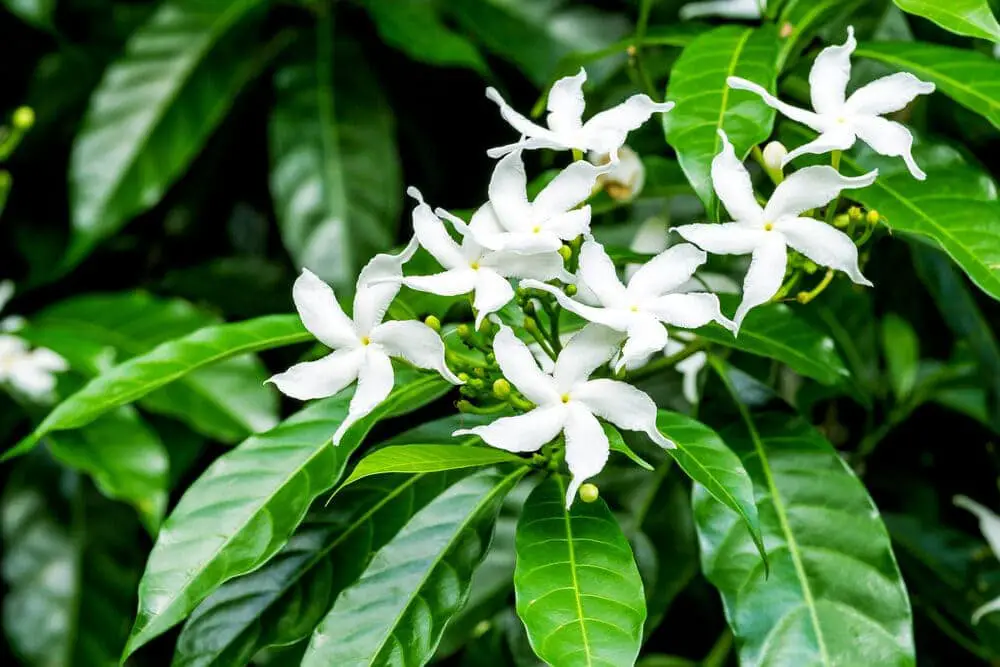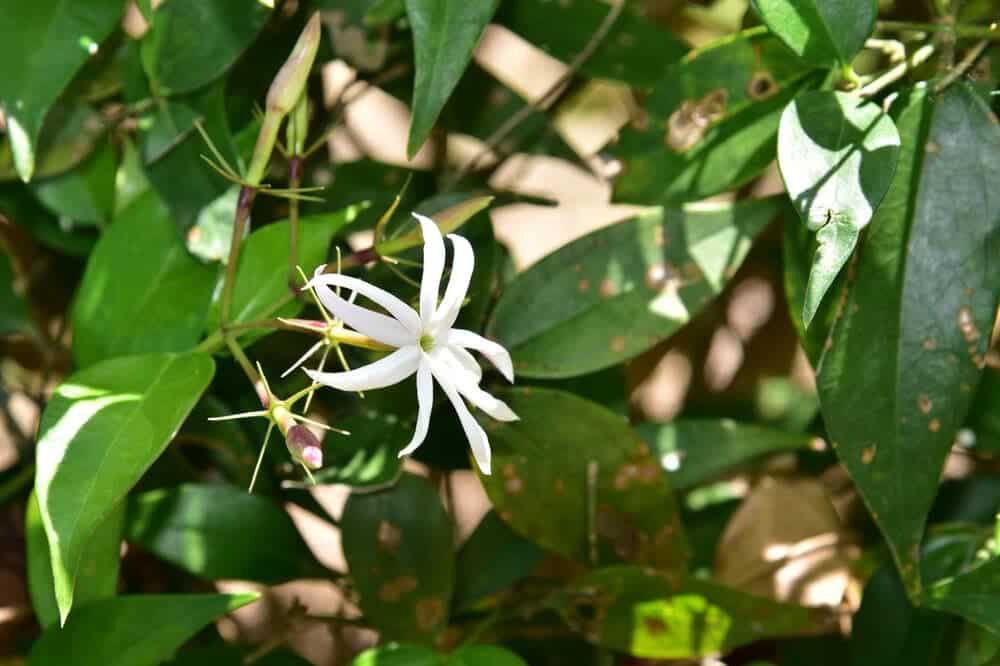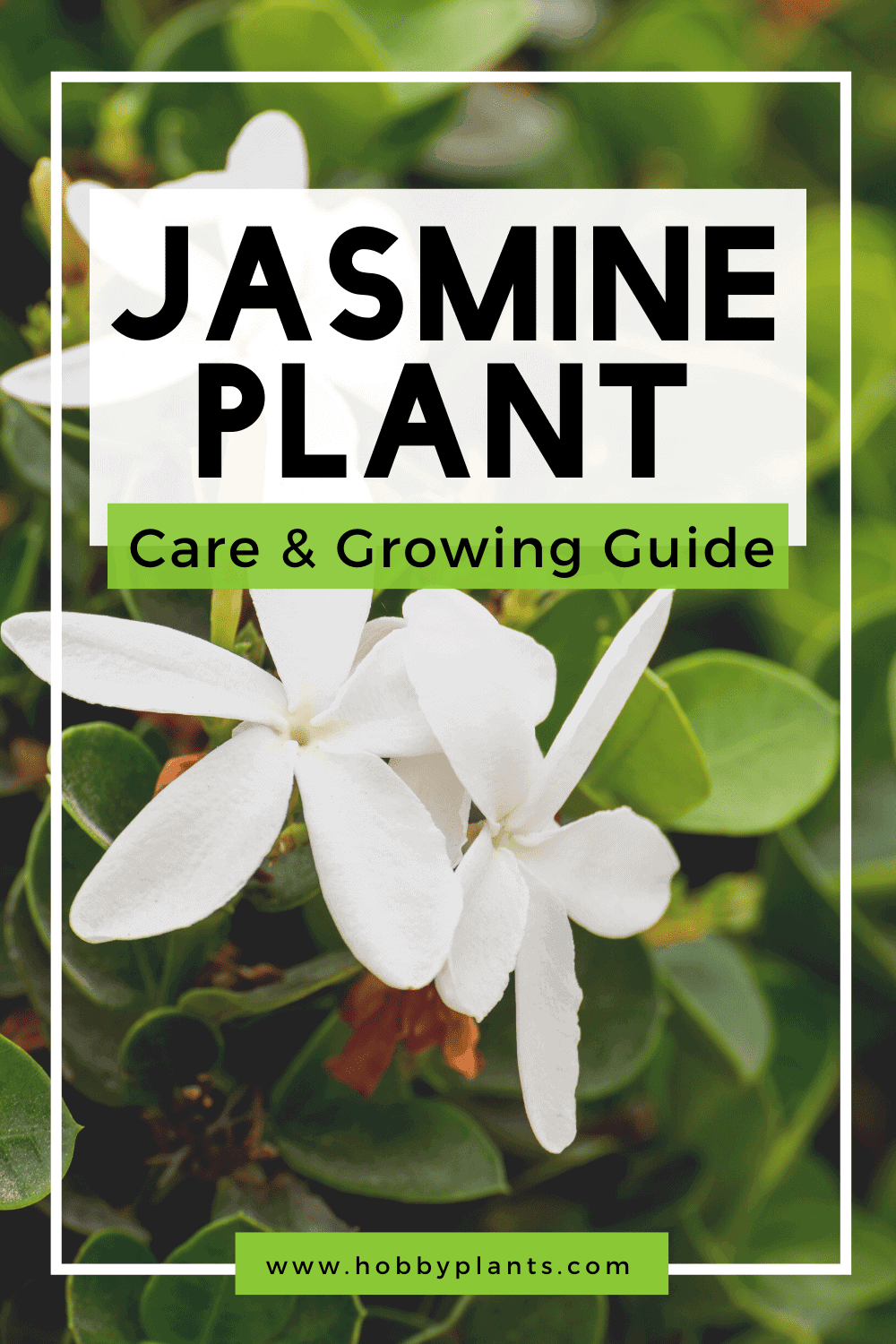This is a tropical plant that has over 200 species with their sweet scent being used in perfumes but not all Jasmine is aromatic.
They are also known for having herbal properties. Some are evergreens and can be bushes or vines. Some varieties of Jasmine are the national flowers of Indonesia, Pakistan, and the Philippines.
The Common or Poet Jasmine is the one that has the sweet smell while the Winter Jasmine is unscented.
Jasmine Plant Care & Growing Guide
1. Light Requirement
The Jasmine plant grows better in part or full sun to partial shade. The ideal planting spot outdoors would be sheltered, warm, and sunny. As a houseplant, Jasmine needs to have a space near the south window to get the sun.
2. Water
The soil of your houseplant should be moist. During the summer, let the soil dry between watering. In the fall you will need to water them less. During the winter and spring months, keep it slightly dry.
The Jasmine houseplant needs to be fertilized twice a year, using a fertilizer that is rich in phosphorus and potassium. In the spring and summer, during the growing season, you can feed it liquid fertilizer every few weeks.
3. Climate
USDA Hardiness Zone 7-10
4. Soil
The soil for the houseplant needs to be a porous material that contains peat, bark, and other soil so it will drain properly. Make sure that the soil is moist but not soggy.
5. Temperature
Indoors, the temperature needs to be kept between 60-75 degrees Fahrenheit with air that is well-circulated.

6. Repotting
One way to know that your Jasmine plant needs to be repotted is that if you water it and then a few days later it needs to be watered again, it is time to repot. Take your houseplant outside and lay the pot on its side on the grass. You can do this inside if you want. Just lay the planter on some newspaper. Slowly pull the root ball from the pot by gently tapping on the side of the planter. Once you have slid the plant out, you need to inspect the roots.
If any of the roots are dark brown or black, cut them off. Loosen the roots with your hand to remove as much of the old soil as you can and to untangle the roots. Any long strands of root need to be cut off. Make four vertical slits in the root ball, going from top to bottom. Space out the slices equally around the root ball to encourage new roots to grow. Repot in a pot that is two inches larger across than the old one, fill with fresh potting soil, and plant.
7. Speed of Growth
Common Jasmine can grow 12-24 inches each year.
8. Height and Spread
The rich green leaves have five to nine leaflets that can be as long as two and a half inches with flowers up to one inch on the Common or Poet’s Jasmine plant. When they are grown as a vine, the Common Jasmine can grow to a height of 10-15 feet with the Winter Jasmine growing to four feet high and seven feet wide.
9. Flowers
The flowers the Jasmine plant produces are white blooms that often have pink highlights on the petals and are star-shaped. The flowers produce a sweet smell that can be calming to your body. Some flowers may also be ivory or yellow. The unscented Winter Jasmine has yellow flowers.
10. Trimming
When you grow Jasmine as a shrub, it can become semi-vining and lanky so it will need to be trimmed quite frequently. You will need to trim the Jasmine plant after flowering to help restrain growth because you do not want it to grow out of control. Also, you will need to pinch the tips to stimulate lateral growth. When it is used as a groundcover, trim the upward twining stems.
You should do your trimming in the spring after it has flowered to get rid of the old, thin shoots. With the shrub, you should trim it in order to maintain its shape and size like you want to be

Is Jasmine Plant Poisonous?
The Jasmine plant is not poisonous to animals or humans.
Can Jasmine Plant grow in Water?
No, you cannot grow Jasmine plant in water. You have to grow them in soil, even cuttings.
How to get Jasmine Plant to Flower?
Trim it and remove all the dead flowers will help encourage it to flower.
Also read: Umbrella Plants Care & Growing Guide
Common Plant Diseases
Jasmine Plant is prone to a variety of diseases, including:
- Spider mites—these are generally found on Winter Jasmine. When this happens, cut the plant to the ground after it has bloomed and get rid of the infested plants. You can then feed the crowns to stimulate new growth.
- Yellowish leaves—this is an indication that your Jasmine plant needs fertilizer. The fertilizer should be applied in the spring.
- Mealy bugs—these are sometimes found on houseplants. You can get rid of them by wiping the leaves with a cotton ball that was dipped in alcohol.
Similar post:
Conclusion
- It is a climber and looks great climbing a trellis or fence but it can also be pruned to be a shrub near a walk or house.
- The Jasmine plant attracts butterflies and hummingbirds.
- The flowers of the Winter Jasmine appear in the winter or early spring before the leaves unfold.
- Winter Jasmine can be used as a good bank cover and will spread by rooting wherever the stems touch the soil.
- Indoors, they will grow well in regular garden soil that is well-drained with a moderate amount of fertilizer.
- If you are growing a twining vine, they will need to be supported on some type of trellis. Most of the houseplants are the Common Jasmine so they will need a trellis to climb. You can purchase a dwarf Jasmine plant for indoors that does not climb.
- When you use it as a shrub border, you have to set them at least eight feet apart.
- Common Jasmine is relatively problem, disease, and pest-free.
- Jasmine does not automatically start to climb a trellis but instead, you have to train it to climb. Some of the weaker vines may be secured to the trellis.

Victoria is the owner and main author of hobby plants. She loves spending her free time in her garden planting and taking care of her plants. Victoria hopes you enjoy the content here!